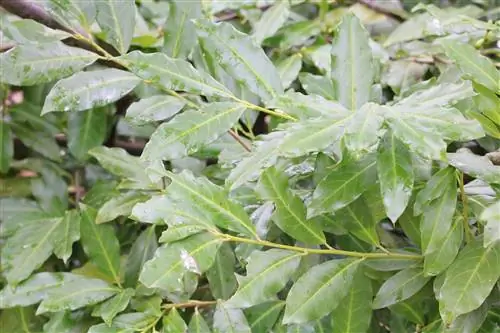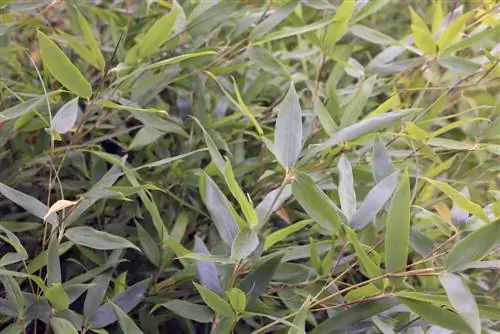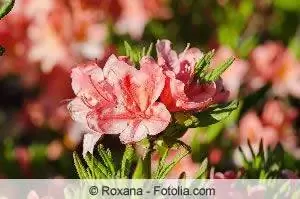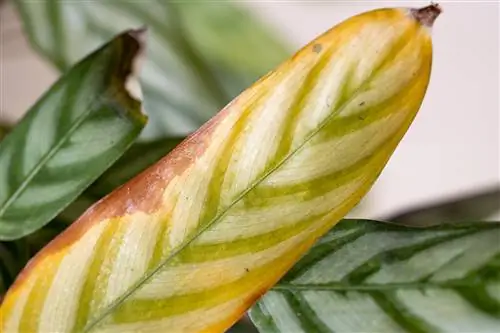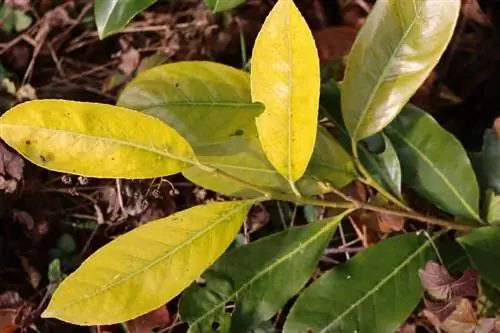- Author admin [email protected].
- Public 2023-12-17 03:39.
- Last modified 2025-01-24 12:45.
The dilemma begins with individual, yellowed leaves. If these early signs of a problem on the oleander are underestimated, over time all the leaves will turn yellow and fall off. Since various causes can cause this damage, there is no panacea to answer the question. By putting all the basic conditions of cultivation to the test, the true cause of yellow leaves on rose laurel ultimately emerges. Find out what to do to get your suffering oleander back on track here.
Cause: drought stress
What to do: Water correctly
The water needs of an oleander cannot be overstated. The magnificent flowering tree is so thirsty, especially in summer, that the saucer should be permanently filled with water. Your rose laurel reacts to drought stress within a short time with yellow leaves. Once all the nutrients it contains have been transferred to the roots, the shrub sheds its leaves to reduce the rate of evaporation. Instead of watering an oleander according to a strict schedule, please change the water supply immediately like this:
- Dip a dried root ball into water until no more air bubbles appear
- During the warm season, place the bucket in a tall saucer filled with water
- Water the substrate whenever it is dry
- Refill evaporated water in the coaster promptly
- Never water the rose laurel under direct sun
Although the oleander comes from the Mediterranean region, it requires calcareous water. Therefore, please only use normal tap water at normal room temperature. Daily gardening practice has proven that soft rainwater causes a lack of lime, causing the leaves to yellow.
Tip:
An oleander can be safely watered with water from the rain barrel if the resulting limescale deficiency is compensated for. For this purpose, sprinkle garden lime or algae lime on the soil every six months and water again.
Cause: nutrient deficiency
What to do: Fertilize in a balanced way
If the yellow leaves in the oleander spread evenly, this indicates a nutrient deficiency. This is particularly true if the damage occurs in the middle of the summer growth and flowering period. Please remember that rose laurel is one of the most consuming plants. Therefore, check the nutrient balance to switch to these intervals if necessary:
- Fertilize weekly from May to August
- Apply an NPK fertilizer at 15-10-15 or higher
- Ideally add to irrigation water as liquid fertilizer
- Before and after watering with clear water
The rest of the year you stop feeding nutrients. Outside of the flowering period, your oleander does not need any additional fertilizer. On the contrary, this could lead to over-fertilization, which in turn causes the leaves to yellow and fall off.
Cause: aging
What to do: Cut back or rejuvenate
As an evergreen flowering shrub, an oleander does not shed its foliage in autumn and winter. However, this characteristic does not mean that the individual leaves live forever. In fact, an oleander leaf lives for about 2 years. At the end of its life, it releases its remaining nutrients to the bush, turns yellow and falls to the ground. Over time, this natural process leads to aging from below. The young leaves above no longer allow enough light to pass through, so that fallen leaves at the base are not renewed. If you can identify this process as the cause, pruning will solve the problem. How to do it right:
- Thoroughly thin out an oleander at least once a year
- Cut off dead wood and shoots that are too close together at the base
- Short branches that are too long by up to three thirds
- Make the cut just above the base of a leaf
If the annual shape and maintenance pruning has been neglected for several years, so many yellow leaves have fallen off that the baldness has progressed to an advanced stage. Thanks to its robust pruning tolerance, you can rejuvenate your oleander. Pruning can be done up to a shoot height of 10 cm. The bush sprouts quickly from the old wood so that it regenerates itself within 1 to 2 years.
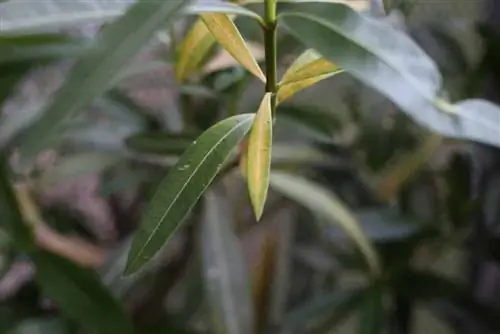
Tip:
The high toxic content in oleander requires wearing long-sleeved clothing and protective gloves. The toxic clippings should not be disposed of in the compost, but in household waste.
Cause: Wrong location
What you need to do: Move immediately
As a Mediterranean plant, oleander loves the sun and has no winter hardiness. This has the advantage that the opulent flowering shrub can cause a sensation on the balcony and terrace from spring to autumn. If it doesn't like the assigned location, the rose laurel reacts with yellow leaves that fall off sooner or later. Since the frost-sensitive plant relies on cultivation in a bucket, you can optimize the location if in doubt. The damage regenerates quickly under the following conditions:
- Relocate to a sunny, warm location
- Protection from wind and rain is recommended
- Preferably on the south side of the house
Leaves with yellow spots often develop immediately after clearing out. This damage occurs when an oleander is placed in full sunlight and suffers sunburn. As a sure sign of this cause, the yellow spots do not spread any further. By allowing a rose laurel to acclimatize in a partially shaded location for 1 to 2 weeks, you can effectively prevent such leaf damage. Affected leaves should not be removed as the remaining green tissue continues to participate in vital photosynthesis.
Cause: Improper wintering
This is what you have to do: Overwinter appropriately
An oleander is robust enough to stay outdoors in mild winter locations. This applies, for example, to the Rhineland or the wine-growing regions. As long as the thermometer does not fall below -5 degrees Celsius at night, no special precautions are necessary. However, where things are harsher in winter, there is a risk of yellowing and leaf loss if a rose laurel is not properly managed through the cold season. Therefore, question overwintering to create the following ideal conditions:
- Put the oleander in a light-flooded winter quarters
- I'm happy to go to the unheated winter garden, the bright staircase or the sunny garage
- Compensating a deficit in light with plant lamps
- Temperatures between 0 and 10 degrees Celsius are optimal
- The darker the room, the lower the temperatures should be
- Reduce watering without letting the root ball dry out
- Do not give fertilizer

Lack of light, temperatures that are too low and too high cause your rose laurel to pull in and shed its leaves. After you have optimized the conditions, the shrub will recover within the following weeks and months. If there is no better winter quarters available, this is no cause for alarm. By the time you clear out your oleander in spring, new, lush green leaves will sprout.
Cause: root pressure
What needs to be done: repotting
When your oleander is young, its growth progresses so quickly that the pot is completely rooted within a year. If the ornamental shrub is not repotted into a larger container with fresh soil, the resulting root pressure will affect the supply of the leaves. These turn yellow and fall off, even though they are watered and fertilized regularly. If the root strands grow out of the opening in the ground and push up through the substrate, repot the restricted rose laurel like this:
- The best time is in early spring, shortly before clearing out
- The new bucket is no more than 5 to 10 cm larger in diameter
- Fill the container one third with a mix of potting soil, clay and sand
- Tie the shoots together with a string and pot the oleander
- Clean out all yellow leaves
- Shake off or rinse off the used soil
- Cut out softened roots
If you want to use the previous pot again, you can shorten the roots by 2 to 3 cm. Plant the rose laurel so that the previous depth is maintained. Pour generously. So that the stressed shrub can recover, it stays in a partially shaded, protected place for 8 to 10 days.
Cause: Oleander cancer
What to do: Fight naturally
If you have been able to rule out all the causes mentioned so far, there is reason to believe that the plant is suffering from oleander canker. In addition to the yellow, falling leaves, the shoots are also covered with gray-brown to black growths. Above these growths, the branch dies, which causes yellowing and leaf drop. Oleander cancer is caused by a bacterium. Experts assume that all European oleanders are infected with it. Whether the disease actually breaks out depends on the constitution and resistance of the respective plant. This is what you need to do now:
- Cut back all affected shoots to he althy wood
- Dispose of the infected clippings in household waste
- From now on, pay attention to optimal care to increase resistance
Scientific observations have proven that a vital and strong oleander can certainly live with the infection. The more vigorous the bush, the quickly it will close the gaps with fresh shoots and young leaves.
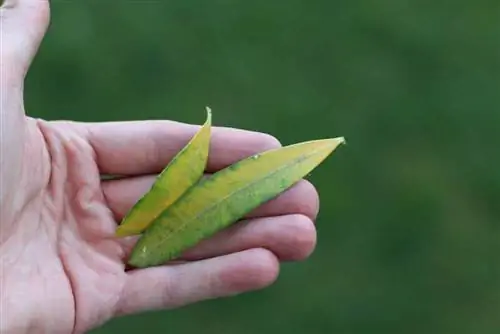
Tip:
The main vectors of cancer-causing bacteria are contaminated cutting tools. Before cutting your oleander, scissors or knives should be disinfected with high-percentage alcohol.
Cause: Lice of all kinds
What to do: Combat with home remedies
The juicy, evergreen leaves are a favorite target of all kinds of lice. Aphids, scale insects, mealybugs and mealybugs have no qualms about settling on the leaves. The pests use their mouthparts to pierce the tissue and extract the plant sap from the foliage. As a visible symptom, the leaves change color, often curl up and fall off. Here's how to combat the plague with home remedies:
- Quarantine the affected oleander
- Remove all leaves infected with pests
- Rush the bush - upside down if possible
- Wipe leaves and shoots with a cloth soaked in alcohol
As a natural control agent, the classic soft soap solution puts an end to infamous lice. Put 1 liter of lime-free water and 1 tablespoon each of soft soap and spirit into a spray bottle. Use this spray to treat the top and bottom sides of the leaves every 2 to 3 days to destroy the last lice.
Conclusion
If your oleander has yellow leaves and they are falling off, a variety of triggers can cause the damage. Therefore, subject the entire cultivation to a detailed analysis. The spectrum of possible causes extends from drought stress, nutrient deficiency and aging to incorrect location and improper wintering to root pressure, oleander cancer and pests. Once you have identified the actual cause, your troubled oleander will recover as a result of appropriate measures. These instructions not only show possible causes, but also explain specifically what to do.


